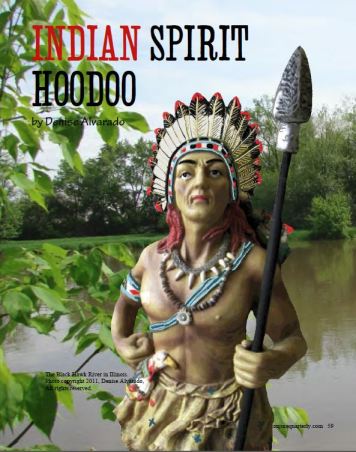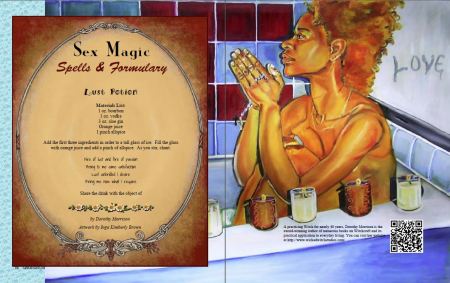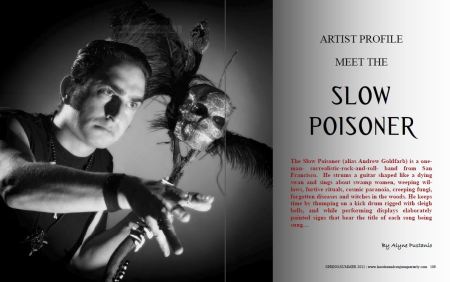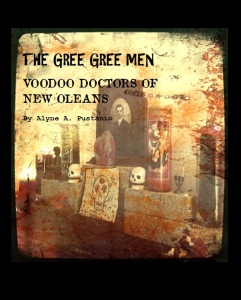If you were wondering what is inside Hoodoo and Conjure Quarterly Issue #2, this blog will answer that question. It is over 50 pages longer than the premiere issue and chock full of good and interesting information. I hope you have a minute or two because we have a lot to cover including our new contributors and some fabulous new artwork to go with their incredible articles.
REGULAR FEATURES
For those of you interested in the Native American influence on Hoodoo and conjure, I have written an article Indian Spirit Hoodoo that discusses some of the various Native American herbs and curios that can be found in New Orleans Hoodoo.
Appalachian Hoodoo practitioner Byron Ballard, also known as Asheville’s Village Witch, reminds us of the benefits of DIY Hoodoo in her article Homegrown and Homemade: How to Grow a Botannica in Your Backyard.
A fascinating look into the journey of Doc Miller and his legendary Hoodoo Drugstore is presented in Issue #2. Who knew that it would be a mess of cobwebs that would make a believer out of Doc Miller?
CHARMS AND FORMULARY
Of course we have a nice selection of charms and formularies for those applied folk magic practitioners out there. The illustrious Dorothy Morrison brings us her Sex Magic Formulary with artwork by our new artist Inga Kimberly Brown.
For our readers interested in GLBTQ issues in the ATRs, Chiron Armand brings us his article The Lavender Passage. Armand is a magickal practitioner for almost a decade, he is an initiate in the Unnamed Path shamanic tradition.
NEW FEATURES
We have a new column brought to you by Koz Mraz called Myth, Magick, and Motorcycle and he takes us along his journey to Joshua Tree. You may be interested in knowing that it is Koz’s band Studio Voodoo that provides the music for our video trailer.
CONJURE ARTIST PROFILE
Contributed by Alyne Pustanio is our featured conjure artist profile on The Slow Poisoner (alias Andrew Goldfarb). According to Pustanio, Andrew Goldfarb “is a one man surrealistic-rock-and-roll- band from San Francisco. He strums a guitar shaped like a dying swan and sings about swamp women, weeping willows, furtive rituals, cosmic paranoia, creeping fungi, forgotten diseases and witches in the woods. He keeps time by thumping on a kick drum rigged with sleigh bells, and while performing displays elaborately painted signs that bear the title of each song being sung…” (Pustanio, 2011, p. 109).
INTERNATIONAL CONJURE
And as the infomercials say “But wait, that’s not all!” We also have a couple of new contributors that offer their experiences with conjure from an international perspective. Witchdoctor Utu gives us a unique glimpse into working with Mama Moses (Harriet Tubman) and the ancestral spirits of the underground railroad in Canada. Utu discusses the historical background of Harriet Tubman and the Underground Railroad and shares with the reader how to build a cairn to honor Mama Moses and the ancestors. He is the founder of the Dragon Ritual Drummers, the Niagara Voodoo Shrine, and is a member and drummer for the New Orleans Voodoo Spiritual Temple.
And then we are proud to have African-born Winsom Winsom from Belize, a very wise woman I am honored to call my friend and soul sister. Yes, that is her real name and it means “Covering of the Ocean.” She shares with us her experiences with the death rites of Belize. Winsom holds multiple initiations including initiation into the West African fetish healing tradition and initiation in Matanzas, Cuba as a Priestess into Santeria. Winsom studied and worked with healers such as Sobonfu Some, and Malidome Patrice Some and has taken part in Rituals in New Orleans Priestess Miriam and others. According to Winsom, “I continue to bring about the synchronization of my art and spirituality and believe “true power originates internal spiritual enlightenment, and that we must use this power to reach our higher selves: creating harmony”. Yeah, now that’s what I’m talking about!
Continuing with our international contributors, we have with us Doktor Snake, legendary bluesman, cult author, and Voodoo conjurer from England. He shares with us the story of how his Hoodoo mentor Earl Marlowe first taught him How to Your Soul to the Devil at the Crossroads. Doktor Snake also wrote the kick-ass forward for my new book the Voodoo Hoodoo Spellbook.
FOLKLORE
No magazine about Hoodoo, conjure and the indigenous traditions would be true to the cause without the inclusion of folklore. Oral tradition is the cornerstone of indigenous knowledge. It is the means by which our ancestors pass on their wisdom and ways of life so that we may benefit and carry them to generations to come (Alvarado, 2011). Following this train of thought, we have included not only the article by Doktor Snake, How to Sell Your Soul to the Devil at the Crossroads, we also bring to you How Br’er Rabbit Lost his Foot or The Rabbit in Magic and Folklore by Matthew Venus and the Plate Eye by Carolina Dean.
Of course, our resident New Orleans folklorist and my homegirl Alyne Pustanio presents a fabulous article on The Gree Gree Men: Voodoo Doctors of New Orleans as only she can tell it.
TUTORIALS
We have gotten some very good feedback about the tutorials we offered in the first issue and so we have continued to meet the needs of our readers by providing some very unique tutorials in this issue, as well. For example, Aaron Leitch, author of Secrets of the Magickal Grimoires, and The Angelical Language: Vols.I and II brings us an Offering Ritual for Archangel Iophiel where he not only tells how to petition this angel for assistance but also provides a tutorial for making Jupiter Cakes.
Among my personal contributions to this issue of Hoodoo and Conjure Quarterly is the very New Orleans Voodoo tradition of How to Make Red Brick Dust that follows my Curio Spotlight on Red Brick Dust.
I also provide a tutorial for making Ant bed Conjure Dolls to go with my article on Mississppi Death Conjure or Killing Hurts. Don’t let the title scare you off – this is a class of works that goes way back in the Hoodoo tradition before Hoodoo even arrived on these shores. There are also a couple of video tutorials that go along with the article and tutorial that can be found on our YouTube channel hoodooconjurejournal.
Part 1 of Mississippi Death Conjure is based on a class of hoodoo spells referred to as “death conjure” or “killing hurts”. Part 1 illustrates the creation of two conjure doll babies and their preparation for the ant bed spell.
Part 2 of Mississippi Death Conjure documents the “Ant Bed Spell”, based on a class of hoodoo spells referred to as “death conjure” or “killing hurts”. Part 1 illustrated the creation of two conjure doll babies and their preparation for the ant bed spell.
Now, its no secret that I am a lover of doll conjure, having authored two books that focus exclusively on that subject, Voodoo Dolls in Magick and Ritual and The Voodoo Doll Spellbook. Another of our contributors is also a well-versed doll conjurer in his own right, Carolina Dean. Between the two of us, you can be sure to find something on doll conjure in every issue of Hoodoo and Conjure Quarterly. Dean gives us a slightly more palatable tutorial than mine in his article Spirit Dolls. He tells how to prepare the doll, how to call a spirit into the doll and how to work with it for any practical magical purpose.
Then we have for you another type of fetish tutorial brought to you by Madrina Angelique. This is How to Make a Business Elegba specifically for the layperson. For those who may need a little help with their businesses and finances, try making one of these powerful fetishes and see what happens.
ARTWORK
Finally, if you thought the artwork was off the hook in the premier issue, wait til you see this issue! The screenshots I have posted for this blog gives you a good idea of what to expect but there is so much more I am NOT showing and that you will only find in the magazine itself. I have created some powerful pieces to complement our contributor’s articles, and Karen Miranda Augustine has provided us with her take on Pomba Gira while Ricky Pustanio gives us his interpretation of the gree gree men. We also have two new artists, Inga Kimberly Brown and the Slow poisoner, aka Andrew Goldfarb. And we cannot forget the fantastic photography provided for us by Matthew Venus. I’m telling y’all, you won’t want to miss this issue!
There is much more to this issue than I have presented here, but this will give those of you who have yet to see the magazine a good preview of what you will find within its pages. No go forth and get your own copy of Hoodoo and Conjure Quarterly #2, the magazine that looks, feels, and reads like a book!






















